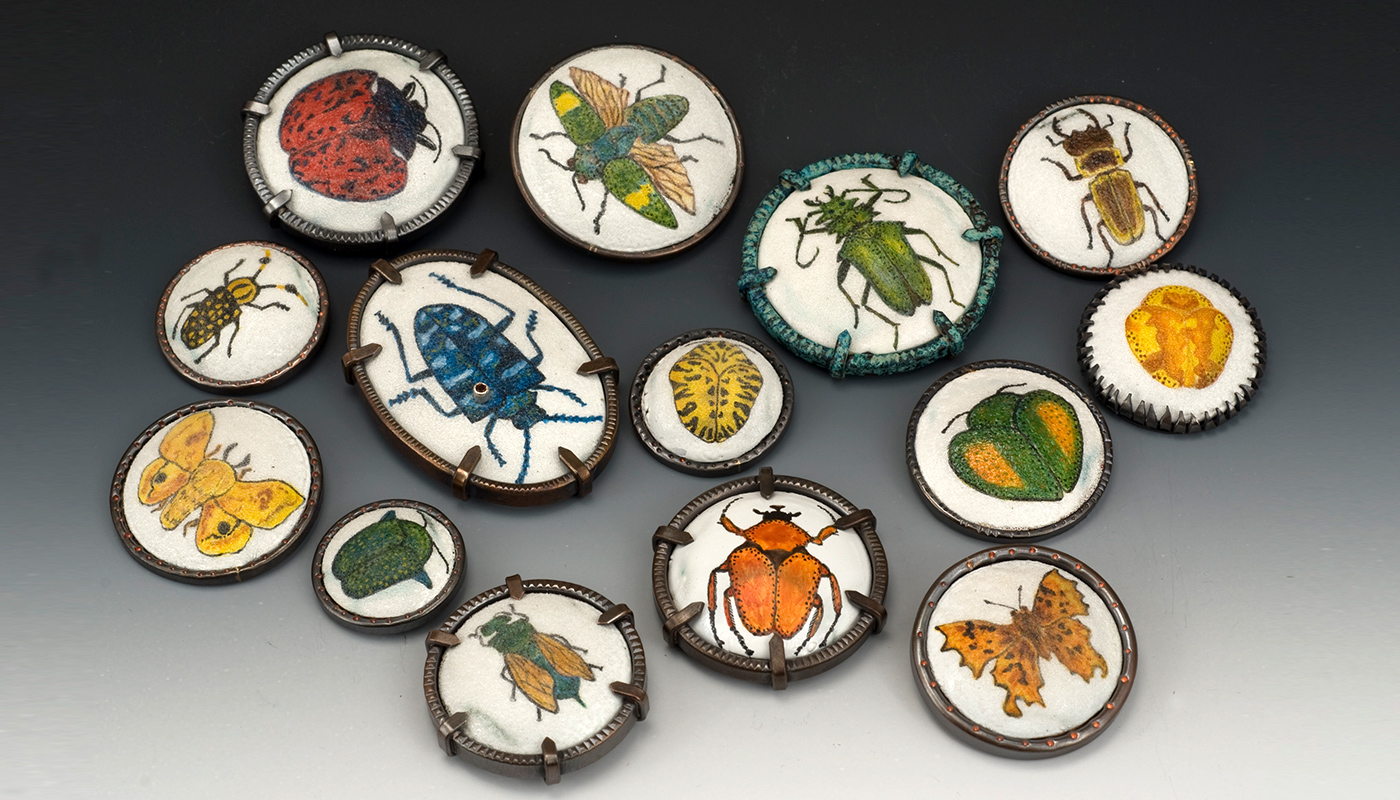
16 Aug The Fantastic Flora & Fauna-inspired Jewelry of Charity Hall
Charity Hall is a full-time metalsmith and studio artist with an MFA in Metal Design from East Carolina University. Charity is a member of the Southern Highland Craft Guild and often teaches jewelry and enameling classes at the Folk School. Before becoming a full-time artist and metalsmith, Charity worked as a biological surveyor and as a U.S. Forest Service botanist where she nurtured her love of the natural world. Her deeply ingrained love for flora and fauna inspire every piece of her work which cleverly showcases overlooked animals, insects, and their brilliant anatomical patterns. Charity recently joined Tammy Elwell for a conversation about her craft. Enjoy our interview.
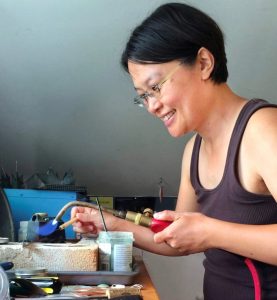
Charity Hall works in her studio.
Folk School Connections
TE: What was your first impression of the Folk School & how long have you had a relationship with the Folk School?
CH: I started teaching at the Folk School in 2013 right after I moved from Tucson, AZ. I thought, “Wow-this is different!” I was very impressed by how many classes are run year-round at the school.
TE: What was the first class that you took/taught at the Folk School?
CH: The first class I taught was an enameling class that focused on drawing and painting techniques.
The first class I took was “Colorful Combinations in Metal and Enamel” taught by Barbara Joiner and Jackie Spencer. At that point, I had already taught an enameling class at the Folk School, but had not yet met Barbara. I knew she was the Resident Artist in Jewelry. I thought I might pretend to be a complete beginner for the first day of class, but she already knew who I was and asked me to teach a jewelry class.
TE: How has the experience of being an instructor and student at the Folk School enriched your life?
CH: Teaching at the Folk School helps me to slow down and share what I love with others.
TE: How have you seen the Folk School grow and evolve since your first visit?
CH: The Work Study Program definitely seems to be growing, which is great. That is definitely attracting people who otherwise might not come to the Folk School. I have also seen continual improvements to the housing and studios. The addition of a salad bar in the Dining Hall is wonderful.
TE: Is there a class that want to take but haven’t gotten a chance to yet?
CH: I would love to take Alan Young’s Wildlife Drawing class. I have always admired the work that his students create.
TE: What are some of the aspects of being at the Folk School that makes it a special place for you?
CH: The studios are great, the people are generous and kind, and there is dessert at every meal.
TE: Do you have a favorite spot on the Folk School campus?
CH: I enjoy early morning walks along the trails behind the Blacksmithing Shop.
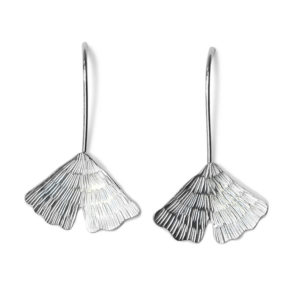
A Variety of Enameled Gingko Leaves
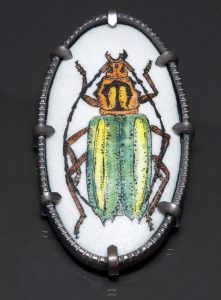
Beetle Brooch
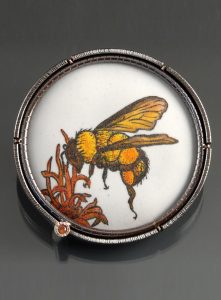
Bee Brooch
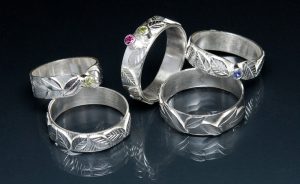
Botanical Rings
The Process/Inspiration
TE: Could you tell me a little bit about how you started in metalsmithing? You spent time making jewelry as a hobby while working as a botanist but how did you discover metalsmithing to begin with?
CH: I spent the summer after my first year at Colorado College working full time in the library. I saw that my college’s arts and crafts program offered a non-credit jewelry class. I signed up even though I had no particular interest in jewelry. Soon, I realized that I loved sawing, soldering, and forming metal. I continued taking classes in metals, weaving, and papermaking over the rest of my time as an undergraduate biology student.
TE: Could you describe your creative process and what inspires you?
CH: I am inspired by plants and insects. Sometimes I try to mimic their textures or forms in metal and enamel.
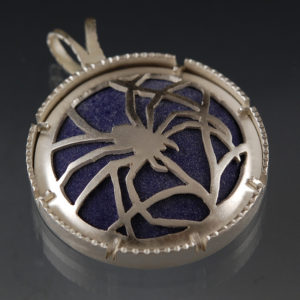
Spider from Bioluminescence Series
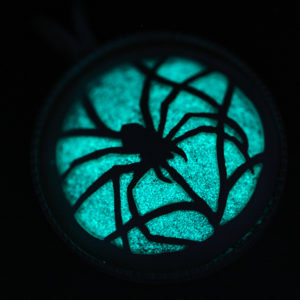
Glowing spider from Bioluminescence Series
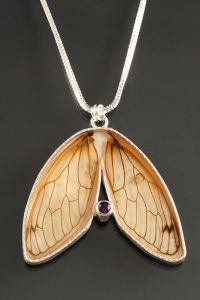
Cicada-inspired Pendant
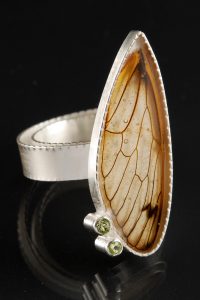
Cicada-inspired Ring
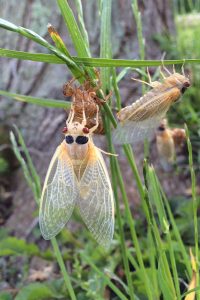
Cicada in the Wild
TE: We’ve carried your cicada wing pendants in the Craft Shop. This year is the 17-year emergence of Brood X cicadas. Do you have any special plans?
CH: Actually, we had a periodical cicada brood emerge in the forests around Blacksburg last year. Whenever I am lucky enough to find masses of cicadas, I look for ones that have already died and carefully remove their wings with tweezers. Then, I dry the wings and store them until I am ready to use them in jewelry.
TE: What brings you the most joy from concept to finished piece?
CH: The processes of drawing and painting images in enamel and of manipulating metal to set stones or add textures is the most appealing.
How do you overcome roadblocks in your creative process?
CH: I try to escape outdoors for a walk or a hike.
TE: Has your experience as an instructor and student at the Folk School influenced your creative process?
CH: Since I started teaching at the Folk School, I have been trying to continually improve the quality of my demos. For enameling classes, this often means demonstrating a painting technique in depth by showing the individual steps that I use to create an image. So, rather than simply making a quick sample that won’t have any further purpose, I try to create an actual piece that will be later set into a brooch or pendant.
TE: You’ve been working in this medium for over 20 years, what is it about working with metals and enamel that continues to attract and fascinate you?
CH: There are an infinite number of possibilities with these materials. Enamel can be monochromatic or vibrantly colorful. Metal can be manipulated into different shapes, forms, and textures.
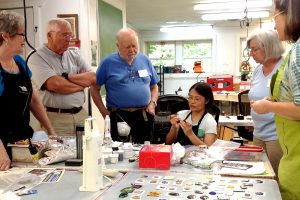
Charity demos techniques for her class in the Folk School Enameling Studio.
Q & A:
TE: Do you have a favorite piece of jewelry or project that you’re making right now?
CH: To be honest, I am not in the studio much at all right now. I had a unique opportunity to spend the entire summer working for the Virginia Department of Conservation conducting rare plant surveys on national forest land. I feel so lucky to be able to learn the Virginia flora and be outdoors.
TE: How would you like your work to connect with people who purchase it?
CH: Hopefully by sharing an appreciation of nature.
TE: Do you have any advice for emerging craftspeople who want to make their living with their craft?
CH: If you live in the southern Appalachians, please look at the Southern Highland Craft Guild. It is a great organization and has been extremely beneficial for my business.
TE: What was the most influential advice that you’ve been given?
CH: Find and do something that you love.
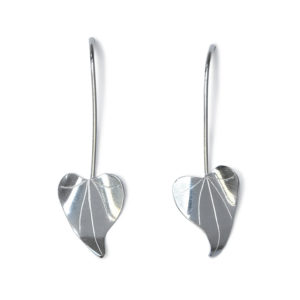
View Charity’s Work in the Craft Shop
Shop for Charity’s jewelry online, call the Craft Shop to inquire about her other work (828-837-2775 ext. 125), or visit the Craft Shop in person.
Craft Shop hours are Monday-Saturday 10 a.m.–5 p.m. & Thursday 10 a.m.–6 p.m.



Sarah Stilley
Posted at 22:36h, 21 AugustI used to visit the Folk School often, and I have an extensive collection of carvings mostly by Hope Brown and some by George Brown. I was wondering how I could get these appraised. I would never part with them, but I was wondering about insuring them. Can anyone help me with this?
Robert Grand
Posted at 09:07h, 26 AugustHi Sarah! Thanks for reaching out. I would contact the Craft Shop with this question. They will not be able to appraise your carvings but may be able to point you in the right direction. Their email is craftshop@www.folkschool.org. Thank you!